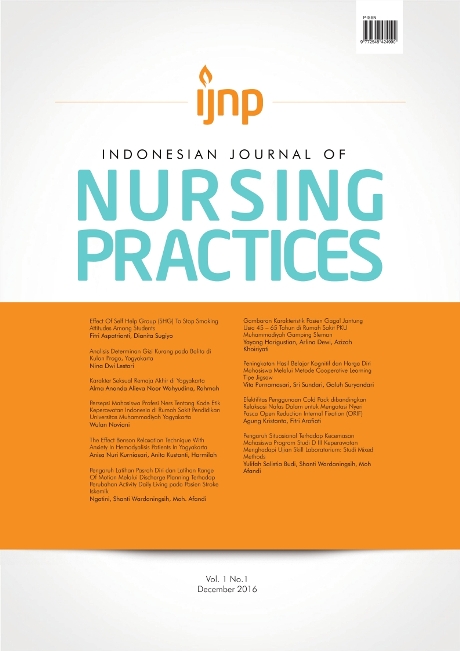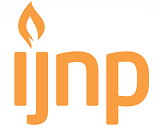Analisis Determinan Gizi Kurang pada Balita di Kulon Progo, Yogyakarta
DOI:
https://doi.org/10.18196/ijnp.v1i1.2682Abstract
AbstrakMasalah gizi kurang balita merupakan masalah aktual di wilayah Kulon Progo, Yogyakarta. Tujuan penelitian ini untuk mengetahui faktor yang mempengaruhi status gizi balita. Penelitian ini menggunakan cross sectional, sampel balita 12-59 bulan sebanyak 155 orang. Data diperoleh melalui kuesioner, status gizi diukur dengan indeks Berat Badan/Umur. Hasil menunjukkan terdapat hubungan bermakna antara usia balita, riwayat pemberian ASI, asupan makanan, persepsi ibu, pola pengasuhan dengan status gizi balita. Faktor dominan yang mempengaruhi status gizi adalah asupan makanan. Diperlukan peran perawat komunitas dalam edukasi dan pemberdayaan untuk meningkatkan status gizi balita.
Kata kunci: faktor status gizi, gizi kurang, balita
Abstract
Undernutrition was still a prior problem in Kulon Progo,Yogyakarta. The objectives of this study were to determine nutritional status in children under five years and related factors. Cross sectional study was conducted with 155 children under five years. Nutritional status was assessed using anthropometric measure- ment. There was a significant association between child’s age, exclusife breastfeeding, child’s dietary intake, caregivers’ practice and mother’s perception with child’s nutritional status and child’s dietary energy intake was the most factor that significant correlated. These findings indicates that the roles of com- munity nurses are needed to improves children nutritional status using education and partnership.
Keywords: factors of nutritional status, undernutrition, children under five years
References
REFERENSI
Almatsier. S. (2009). Prinsip dasar ilmu gizi (edisi ketujuh).
Jakarta: Gramedia Pustaka Utama
Annim, S.K.,&Imai K.S.,(2014. Nutritional status of children, food consumtion diversity and ethnicity in Lao PDR. Economics school of Social Sciece. University of Manchaster. UK
Bantamen, Belaynew, & Dube (2014). Assessment of Factors Associated with Malnutrition among Under Five Years Age Children at Machakel Woreda, Northwest Ethiopia: A Case Control Study. Journal nutrition food science vol 4 No 1 2014 Charmarbaglawa,R.,Ranger.,M.,Waddington H, White H (2010). The determination of child health and nutrition: a meta analysis. Departemen of economic, university of maryland
and operation evaluation departement, world bank Dinkes Kab Kulon Progo (2014). Profil Kesehatan Kabupaten
Kulon progo Tahun 2014 (Data tahun 2013). Kulon Progo, DIY
Handono, N.P (2010). Hubungan Tingkat Pengetahuan pada Nutrisi, Pola Makan, dan Tingkat Konsumsi Energi dengan Status Gizi Anak Usia Lima Tahun di Wilayah Kerja Puskesmas Selogiri, Wonogiri. Jurnal Keperawatan Vol 1 No.1, Juli 2010.
Hayati (2014). Analisis faktor orang tua terhadap status gizi balita. Pendekatan teori health belief model. Program studi ners Fakultas Keperawatan Universitas Airlangga.
Kartika, et al (2000). Pola pemberian makan anak (6-18 bulan)dan hubungannya dengan tumbang anak pada keluarga miskin dan tidak miskin. Jurnal Penelitian Gizi dan Makanan Jilid 23 Tahun 2000 Hal 37-47
Maseta, E., Makau K.W., & Omwega A.M., (2008). Childcare practice and nutritional status of children aged 6-36 months among short ang long term beneficiaries of the child survival protection and development programmes (the case Morogoro, Tanzania). South Africa Journal of Clinical Nutri- tion. Vol 21, No 1, 2008
Mirayanti, N. (2012). Hubungan pola asuh pemenuhan nutrisi dalam keluarga dengan status gizi balita di Kelurahan Pasir Gunung Selatan Kecamatan Cimanggis Kota Depok. Tesis. Fakultas Ilmu Keperawatan Magister Ilmu Keperawatan: Depok.
Naghashpour et al (2014). Nutrition education based on health belief model improves dietary calcium intake among female students of junior high schools. Journal of Health Population Nutrition. Vol 32 , No 3, 420-429p. 2014
Nakamori et al (2010). Nutritional status, feeding practice and incidence of infectious disease among children aged 6 to 18 months in northern mountainous Vietnam. The journal of medical investigations vol. 57.2010
Putri, D.S.K & Wahyono,T.Y.M (2013). Faktor langsung dan tidak langsung yang berhubungan dengan kejadian wasting pada anak umur 6-59 bulan di Indonesia tahun 2010. Me- dia litbangkes Vol 23, No 3, September 2013, 110-121
Riskesdas. (2013). Riset Kesehatan Dasar 2013. Kementerian Kesehatan RI. https://www.litbang.depkes.go.id
Salehi et al (2004). Asessing the impact of nutrition education on growth of Iranian nomadic children: an application of a modified beliefs, attitudes, subjectives norms and enabling factors model. The British Journal of Nutrition, vol 91, 779p
Sartika, R. (2010). An anlysis on the usage of health service related to nutritional status of under five years old children. Jurnal Kesehatan Masyarakat Nasional Vol 5, No.2, Oktober 2010
Stanhope, M. & Lancaster, J. (2012). Public Health Nursing Popu- lation Centered Health Care in The Community . (8th e). Mis- souri: Elsevier.
Unicef (2011). Gender influences on child survival, health and nutrition:a narative review. New York
United Nations Children’s Fund (UNICEF) (2013). Improving child nutrition: the achievable imperative for global progress, UNICEF, New York, 2013.
WHO (2013). The Millenium Development Goals (MDGs) Report 2013. United Nation New York.Diperoleh tanggal 25 Desember 2013 dari http://www.who.int/nutrition/publi- cations/severemalnutrition
Wong et al.(2014). Risk factors of malnutrition among preschool children in Terengganu, Malaysia: a case control study. BMC Public Health Journal 2014, 14: 785
Downloads
Published
Issue
Section
License
License
Articles published in the IJNP (Indonesian Journal of Nursing Practices) are licensed under a Attribution 4.0 International (CC BY 4.0) license. You are free to:
- Share — copy and redistribute the material in any medium or format.
- Adapt — remix, transform, and build upon the material for any purpose, even commercially.
This license is acceptable for Free Cultural Works. The licensor cannot revoke these freedoms as long as you follow the license terms. Under the following terms:
Attribution — You must give appropriate credit, provide a link to the license, and indicate if changes were made. You may do so in any reasonable manner, but not in any way that suggests the licensor endorses you or your use.
- No additional restrictions — You may not apply legal terms or technological measures that legally restrict others from doing anything the license permits.
Copyright
Authors who publish with IJNP (Indonesian Journal of Nursing Practices) agree to the following terms:
- Authors retain copyright and grant IJNP (Indonesian Journal of Nursing Practices) the right of first publication with the work simultaneously licensed under an Attribution 4.0 International (CC BY 4.0) that allows others to remix, adapt and build upon the work with an acknowledgment of the work's authorship and of the initial publication in IJNP (Indonesian Journal of Nursing Practices).
- Authors are permitted to copy and redistribute the journal's published version of the work (e.g., post it to an institutional repository or publish it in a book), with an acknowledgment of its initial publication in IJNP (Indonesian Journal of Nursing Practices).















